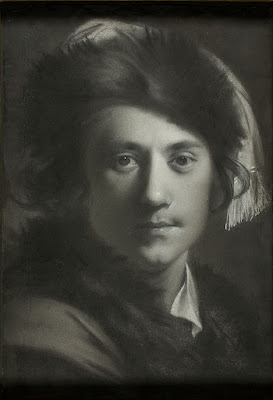 |
| Joseph Wright of Derby Matlock Tor by Moonlight ca. 1777-80 oil on canvas Yale Center for British Art |
 |
| Joseph Wright of Derby Portrait of Fleetwood Hesketh 1769 oil on canvas Walker Art Gallery, Liverpool |
 |
| Joseph Wright of Derby Dovedale by Moonlight ca. 1785 oil on canvas Museum of Fine Arts, Houston |
 |
| Joseph Wright of Derby Portrait of Mrs Frances Hesketh 1769 oil on canvas Walker Art Gallery, Liverpool |
"If art really strove to imitate nature, the matter would be quite simple. The artist would merely cast the object in plaster, and paint its outer surfaces to correspond to nature. A person could then view the object in the closest proximity or from a distance, however he wished, and he would receive a plastic or a painterly impression. However, visual art is not an imitation of nature but a contest with it. The artist wants to present only those aspects of a natural thing that will be pleasing to us. These have changed dramatically through various times and cultures. In some times, people preferred to see things at close range, in others – today, for example – from a distance. This development constitutes a substantial chapter in the history of art, one no less significant than the development of motifs. In the end, the former depends just as heavily as the latter on the sequence of men's worldviews."
– from Historical Grammar of the Visual Arts, a course of lectures delivered by Aloïs Riegl in 1899 at the University of Vienna, translated by Jaqueline E. Jung and published in English by Zone Books in 2004
Riegl talks about the 'sequence' of worldviews through 'various' times and cultures in order to avoid using words like 'succession' and 'progress.' His contemporaries of course mostly accepted the popular fantasies of their day – including 'the march of history' (in one direction only) along a meaningful linear path. Riegl was skeptical of this model, suggesting that taste-cycles (like other temporal cycles) could occur independently and arbitrarily.
 |
| Joseph Wright of Derby Eruption of Vesuvius with view over the islands in the Bay of Naples ca. 1776 oil on canvas Tate Britain |
 |
| Joseph Wright of Derby Portrait of Richard Gildart 17668 oil on canvas Walker Art Gallery, Liverpool |
 |
| Joseph Wright of Derby View of erupting Vesuvius from Posillipo, Naples ca. 1788-90 oil on canvas Art Gallery of South Australia, Adelaide |
 |
| Joseph Wright of Derby Portrait of a man ca. 1755-65 oil on canvas Museum of Fine Arts, Houston |
 |
| Joseph Wright of Derby Iron Forge viewed from without 1773 oil on canvas Hermitage, Saint Petersburg |
 |
| Joseph Wright of Derby Portrait of a man ca. 1768 pastel Yale Center for British Art |
 |
| Joseph Wright of Derby Annual Girandola at Castel Sant’Angelo, Rome ca. 1775-76 oil on canvas Walker Art Gallery, Liverpool |
 |
| Joseph Wright of Derby Self-portrait in fur cap 1765 pastel Art Institute of Chicago |
 |
| Joseph Wright of Derby Self-portrait ca. 1765-69 oil on canvas National Gallery of Victoria, Melbourne |
 |
| Joseph Wright of Derby Lake by Moonlight ca. 1780-82 oil on canvas Yale Center for British Art |